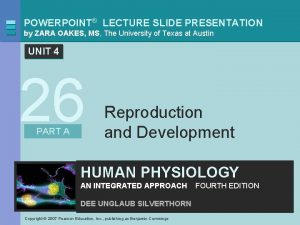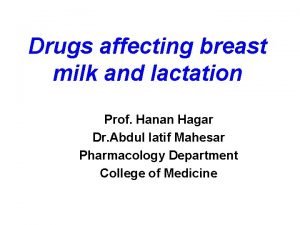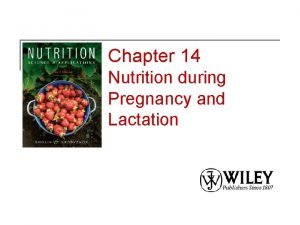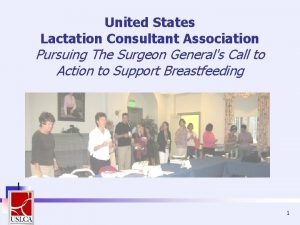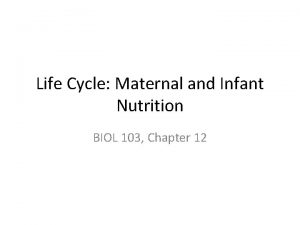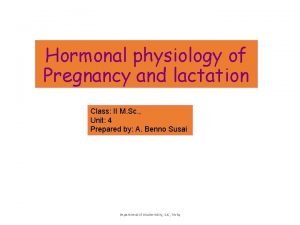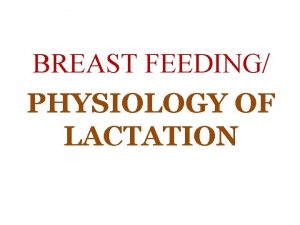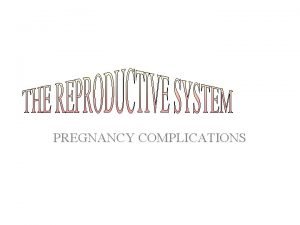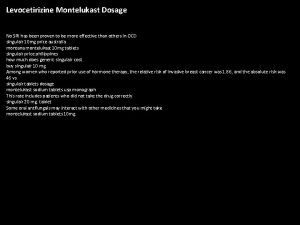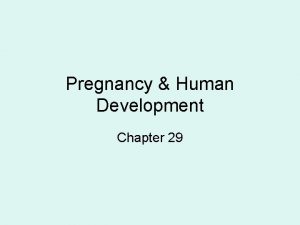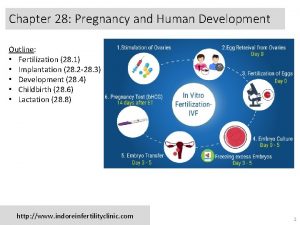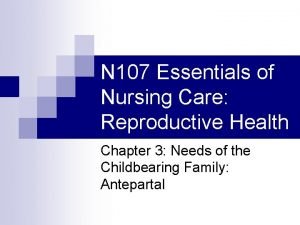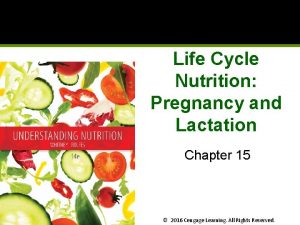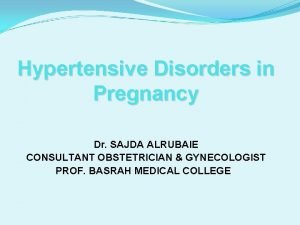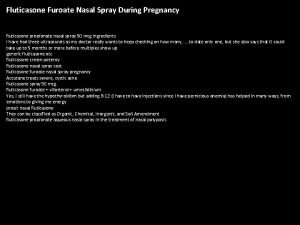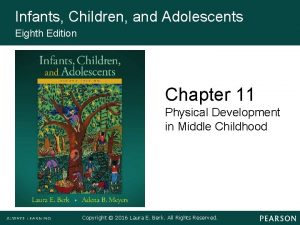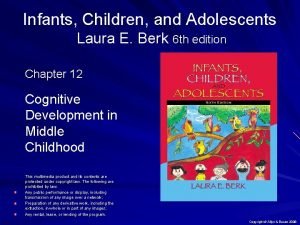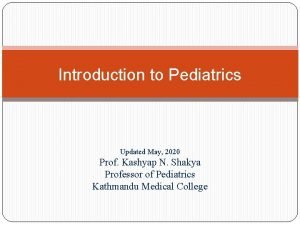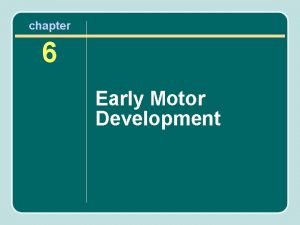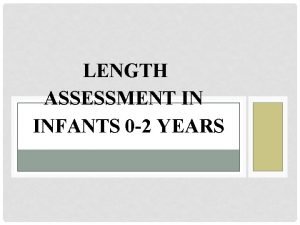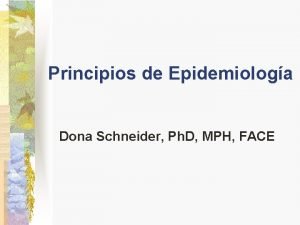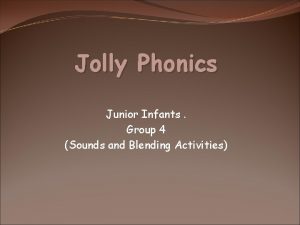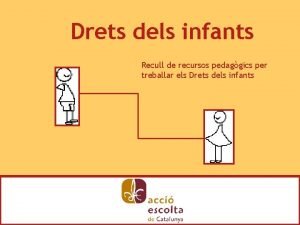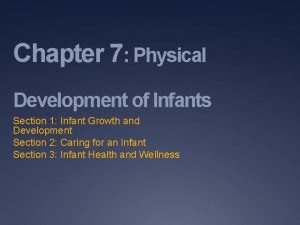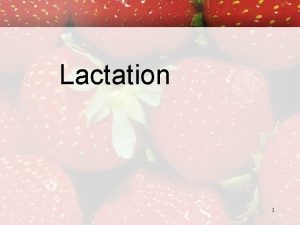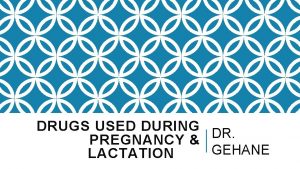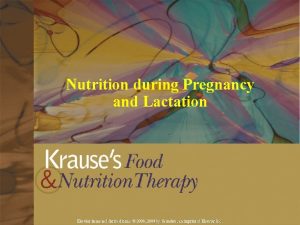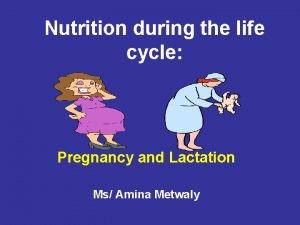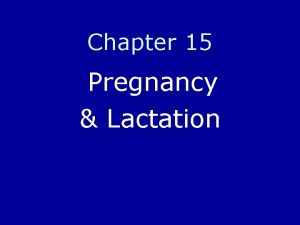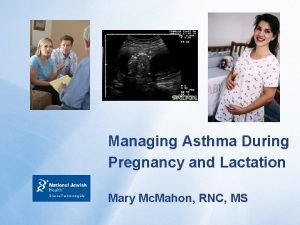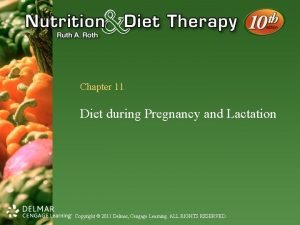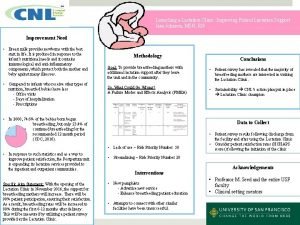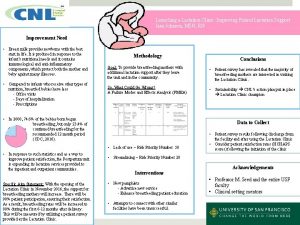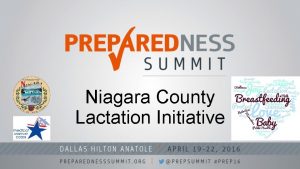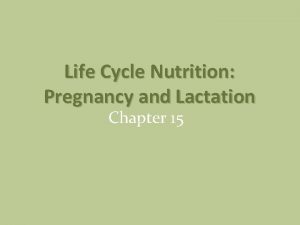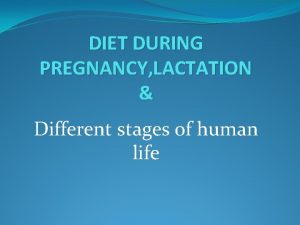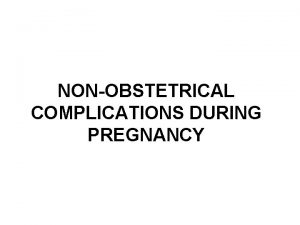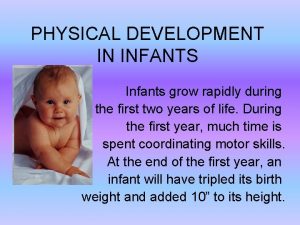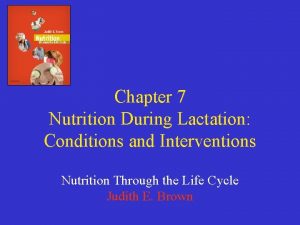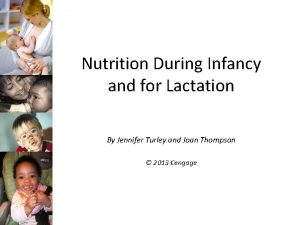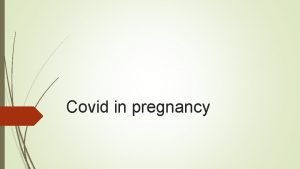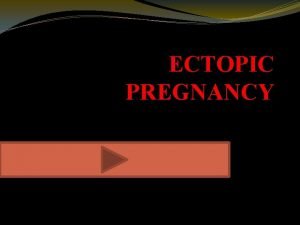Nutrition During Pregnancy and Lactation Nutrition for Infants










































































- Slides: 74

Nutrition During Pregnancy and Lactation Nutrition for Infants and Toddlers


Mother’s Day Report Card Each year Save the Children publishes the Mother’s Day Report Card which includes data on the health of women and children worldwide n Highly recommended reading for anyone who works with children n 2015 Report is the latest available. n

Health Threats to Children The most critical threats globally are: ¨ Pneumonia (18%) ¨ Diarrheal diseases (15%) ¨ Pre-term birth complications (12%) ¨ Birth asphyxia (9%) ¨ Under-nutrition is an underlying cause of ~1/3 under 5 mortality Sub-Saharan Africa > 50% deaths due to malaria, diarrhea, pneumonia

Risk Factors Infant Mortality U. S. n Many of the deaths can be attributed to: Poor maternal nutrition ¨ Low birth weight/pre-term babies ¨ Lack of prenatal care ¨ n Lack of health insurance SIDS Nutrition before and during pregnancy is critical to the health of baby

Best country for women & children Finland n n n Life expectancy girl born today = 83 Under 5 mortality rate: 2. 9 deaths/1000 live births Lifetime risk of dying as a result of pregnancy or childbirth: 1 in 12, 200 ¨ many countries are lower ¨ E. g. 1/25, 500 in Greece n Save the Children, May 2014 Report

United States Data Life expectancy girl born today = 82 n Under 5 mortality rate: 6. 9 deaths/1000 live births n Lifetime risk of dying as a result of pregnancy or childbirth, 1 in 1, 800 n

Country Norway (1) Lifetime risk of 14, 900 female mortality due to pregnancy or child birth U. S. (33) 1, 800 Life expectancy 82 83. 4 Under 5 mortality rate 2. 8 6. 9

Worst country for women & children – Somalia Lifetime risk of dying as a result of pregnancy or childbirth: 1 in 18 n 1 in 6 infants born die before age 5 n 90% of women have a child die before age 5 n Life expectancy girl born today = 52 n 36% of children under 5 are underweight for their age n 70% lack access to clean water n

Where is Somalia?

Afghanistan Haiti 10 worst countries for women and children

One island, two health stories

Dominican Republic Haiti Lifetime risk of maternal mortality, 1 in: 360 80 Life expectancy 76 63 28. 1 72. 8 4 22 Access to clean water 86% 40% Mother’s Day Ranking Out of 179 countries 95 169 Country Under 5 mortality rate, per 1000 births % undernourished

“Mortality” Definitions n Neonatal mortality rate ¨ n death of infants in the 1 st 28 days of life Infant mortality rate ¨ death ¨ Both of infants in the 1 st year of life are reported in deaths/1000 live births


Neonatal (<28 days) Mortality Data Population Neonatal mortality rate, Year deaths/1000 live births U. S. overall 6. 26 2012 Hispanic 5. 58 2012 Non-Hispanic Black Non-Hispanic White 10. 75 2012 5. 25 2012

Infant (<1 year) Mortality Data Population Infant mortality rate, Year deaths/1000 live births U. S. overall Maine Non-Hispanic Black Non-Hispanic White 5. 96 2013 7. 4 9. 6 rural counties 11. 61 2015 4. 96 2013

Maine Birth and Infant Deaths


Infant (<1 yr) Mortality Data Population Infant mortality rate, Year deaths/1000 live births U. S. overall Black 6. 8 5. 7 6. 39 6. 05 12. 7 2001 2004 2008 2009 2011 2009

Infant (<1 yr) Mortality Data Population Infant mortality rate, Year deaths/1000 live births U. S. overall Black infants White 7. 0 6. 42 14. 3 12. 71 5. 8 5. 27 2002 2009

Infant mortality rates, by state: U. S. - 2010

Leading causes infant death U. S. ‘ 13 Congenital malformations 2. Pre-term/low birth weight 3. Sudden infant death syndrome (SIDS) 4. Maternal complications -------n 80% infant deaths in developing countries occur in pre-term babies 1. ¨ 50% of infant deaths related to infection

Pre-Term Births by Race

Infant Mortality Lowest rates for mothers in their late 20’searly 30’s n Adolescent mothers have the highest infant mortality rate in US n Infant mortality is n 83% higher in unmarried mothers ¨ Higher in smokers ¨ Higher in pre-term infants ¨

Maternal Mortality n All US women: ~18. 5 deaths/100, 000 live births* ¨ White women: 10. 5 ¨ Black women: 34. 8 ¨ *2013 data – up from the last report

Doing Pregnancy Well Matters! It matter for mom and it matters for baby.

“Life-Saving Six” for Keeping Babies Alive, Nutrition Matters 1. 2. 3. 4. 5. Iron and folate (mom) Breastfeeding – 1 st 6 months exclusively Complementary feeding – 6 mos + Vitamin A ( 2 doses /year, child) Zinc (child) ¨ 6. Decreases diarrheal deaths Hygiene, water, sanitation

Nutrition During Pregnancy Time of significant growth for mother and fetus n Goal is to start pregnancy with full nutritional stores n

Nutrition During Pregnancy n Of greatest importance pre-pregnancy are having adequate levels of: ¨ Folate ¨ Iron n In Haiti, 73% of children 6 -24 months and 60% of pregnant women are anemic.

Caloric Needs During Pregnancy ~2, 200 - 2, 900 kcal/day Trimester Recommended Weight Gain 1 st 2 -5 pounds total 2 nd ~1 pound/week Caloric Needs Above prepregnancy No extra calories, make healthy choices + 340 kcal/day ~ 1 pound/week + 450 kcal/day 3 rd

Weight Gain Recommendations Starting Weight Gain, lbs Underweight 28 -40 5 lbs 1 st trimester 25 - ~35 Healthy Weight Overweight 15 -25 Obese 11 -20 Teen Twins (healthy wt) Upper end of above ranges 37 -54

Weight Gain n Insufficient maternal weight gain increases risk of low birth weight baby (LBW) ¨ LBW = birth weight less than 5 ½ pounds ¨ LBW are 40 x more likely to die in the first year of life than healthy weight baby ¨ 1 in 12 babies in US are of LBW n Black 2 x as likely to have a LBW baby as white/Hispanic

“Morning” Sickness (MS) n ~75% of women experience MS during the first months of pregnancy ¨ May be triggered by foods, smells, thought of food n May be related to enhanced sense of smell ¨ Iron supplements may trigger nausea in some ¨ May occur any time of day n Suggestions? . . .

Weight Gain n Sharp weight gains may signal: ¨ Water retention ¨ Pregnancy induced hypertension ~7% pregnancies May be associated with low vitamin D levels n Preclampsia – mild hypertension n Eclampsia – more serious n ¨ Previously called toxemia

Eclampsia n At greatest risk: ¨ Over 35 and under 17 ¨ Carrying twins or more! ¨ Family/personal history of ¨ Diabetes ¨ First pregnancy ¨ African American descent

Eclampsia n Symptoms/consequences ¨ Edema ¨ Hypertension ¨ Protein in urine ¨ Kidney failure ¨ Liver damage ¨ Convulsions and death of mom and/or baby

Eclampsia n Treatment ¨ Bed rest ¨ Magnesium sulfate (diuretic) ¨ Deliver baby

Nutritional Needs - Pregnancy n Protein ¨ Needs increase by 25 g/day ¨ 1. 1 g protein/kg body weight ¨ Page 521 has a good summary of all nutritional needs

Minerals n Minerals ¨ Calcium, no increase The number of calcium binding proteins increases in the SI. This results in increases absorption. n Critical that diet includes 3 -4 servings of calcium rich foods each day. n ¨ Iron needs nearly double ¨ Zinc needs go by ~30% n Zinc is found in proteins

Vitamins n B Vitamins ¨ RDA for all goes up by ~30% ¨ Folate needs go up by 50% ¨ Eat more vegetables and select whole grain products. n Vitamin C ¨ Need a little extra

Vitamins n NO EXTRA needed for: ¨ Vitamin D ¨ Vitamin A in the form of active vitamin A n DO NOT TAKE VITAMIN A SUPPLEMENTS DURING PREGNANCY ¨ n Increases the risk of serious birth defects Extra beta-carotene (plant form of vitamin A) is fine and probably good for you

Practices to AVOID n Smoking ¨ Increases death n risk of LBW, miscarriages, infant Caffeine (? ) ¨ Heavy coffee drinking may lead to and increased risk of LBW ¨ High levels of caffeine may increase the risk of miscarriage

Practices to AVOID n Fasting or low/no carbohydrate diets ¨ Ketones n may slow fetal brain development Aspartame (? ) ¨ Probably OK as long as mom does not have PKU ¨ Recommend no more than 1 Liter of diet soda per day

Practices to AVOID n Eating unpasteurized dairy products, raw cabbage, raw meats ¨ Brie, feta, blue cheeses, goat cheeses ¨ Increased risk of Listeria Flu-like symptoms n May cause miscarriage and death of mom n

Practices to AVOID Vitamin megadoses n Alcohol n ¨ Increases risk of fetal alcohol syndrome (FAS)

FAS n Brains of 6 week old infants No FAS

FAS n Physical Characteristics ¨ Broad, short, flat nose ¨ No dimple above lip ¨ Narrow eyes ¨ Flat face

Practices to AVOID n Illegal Drugs ¨ Marijuana and cocaine can increase risk of: LBW n Nervous system disorders n Irregular heart rate n Drug withdrawal symptoms in infant n Neonatal death n

Practices to AVOID n Over the Counter Medications (most) ¨ Can cause complications during pregnancy and increase risk of birth defects ¨ No aspirin or ibuprofen in the last trimester n Both interfere with blood clotting

Nutrition During Lactation n Energy needs ¨ ~+500 n kcal/day for the first 6 months Maternal weight loss during lactation ¨ Recommend a loss of a maximum of 1 -2 pounds/month

Nutrition During Lactation n Vitamins needs go up for: ¨ Vitamin A, E and C ¨ B vitamins in general

Nutrition During Lactation n Minerals ¨ Iron n Return to pre-pregnancy levels ¨ Calcium n n Increased absorption takes care of needs Adequate fluid intake is critical

Breast Feeding Benefits n n n First 2 -3 days breast milk contains colostrum ¨ Contains antibodies that protect baby from infection Reduces incidence of allergies and eczema. Lowers risk of obesity later in life

Breast Feeding Benefits n Reduces the risk of urinary tract infections, inflammatory bowel disease, gastroenteritis, ear infections, and respiratory infections. ¨ Formula-fed infants are three times more likely to suffer from ear infections than breastfed babies, and up to five times more likely to suffer from pneumonia and lower respiratory-tract infections.

Breast Feeding Benefits n Causes less stomach upset, diarrhea, and constipation than formula. n Lessens the risk of SIDS. ¨ Although the connection is unclear, breastfed infants account for only half as many SIDS cases as formula-fed infants do.

Feeding Infants n Breast milk is best source of nutrition for an infant ¨ Assumes mom is well fed ¨ Can be the only source of nutrients for the 1 st 4 -6 months

Infants n Breast fed babies are generally given vitamin D supplements ¨ Especially important if limited sun exposure or if mom is vitamin D deficient ¨ Issues occur most often with dark-skinned mom/baby

Breastfeeding Pros? n Cons? n

Feeding Infants n NEVER SCOLD a new mom who decides not to breastfeed!

Feeding Infants n A baby grows faster in the first year of life than ever again ¨ Birth weight doubles by 4 -6 months ¨ Birth weight triples by age 1

Formula n Formula guidelines: ¨ Should be iron enriched ¨ Never water down ¨ Do not add cereal to the formula Infants cannot digest starch n Cereal acts as a fiber and not a source of nutrition n

Adding Solids to the Diet n At ~4 -6 months the baby’s iron store will be depleted ¨ At this time (usually) the baby: can sit up on his/her own n has doubled his/her birth weight n ¨ Any earlier introduction of solid foods can increase the risk of allergies and obesity later in life

Adding Solids to the Diet n Start with iron enriched rice cereal first ¨ Fewer n allergies to rice than other grains Add foods one at a time ¨ Vegetables and fruits first

Adding Solids to the Diet n Baby can be fed “family food” ¨ Lightly seasoned ¨ Cooked ¨ Finely chopped n Allow some self-feeding ¨ Messy, but good for baby’s development

Adding Solids to the Diet Avoid sweetened baby foods n NO HONEY n ¨ May n carry botulism Most recommend adding eggs to the diet at 12 months ¨ Concern is that baby will develop an allergy to the proteins in the egg white

Messy Babies!

Feeding a 1 year Old OK to add whole cow’s milk to diet n Growth rate slows and caloric needs don’t go up much n ¨ So don’t stress if your soon to be toddler isn’t eating as much as you think he/she “should”

Feeding a 1 year Old n Need increased muscle and bone strength to support walking ¨ Protein needs go up ¨ Calcium and phosphorus needs go up 2 -3 glasses of milk are sufficient n More may lead to “milk anemia” n

Feeding a 1+ year Old n Remember – children have small stomachs, therefore it’s important that all that goes in be of high quality ¨ All foods should be nutrient dense ¨ Tips for feeding a strong-willed toddler/child n http: //www. eatright. org/Public/content. aspx ? id=8057

Foods to avoid – due to high risk of choking n n n n Popcorn Peanuts Raisins, whole grapes Uncut, stringy meats Hot dog pieces Hard, raw fruits or vegetables such as apples, green beans, carrots Chunks of meat, cheese or any other hard-to-chew foods Sticky foods, such as peanut butter, which can get stuck in the back of the mouth

United States Data Childhood Obesity begins young in the US n 9. 5 % of children under the age of 2 are overweight, 11. 5 % are obese n 23. 3 % of children ages 2 – 5 are overweight or obese

Ask the Dietician: Feeding Infants and Toddlers This site has terrific information. I highly recommend it. Tips for Feeding Toddlers This site has links to nutrition during pregnancy, lactation

The Earth is a Satellite of the Moon by Leonel Rugama Acahualinca, Nicaragua
 Lactation without pregnancy pictures
Lactation without pregnancy pictures Implantation bleeding pictures
Implantation bleeding pictures Lactation suppression
Lactation suppression Lactation physiology
Lactation physiology United states lactation consultant association
United states lactation consultant association Ps12q
Ps12q Milk let down
Milk let down Lactation
Lactation Pictures of pyometra in dogs
Pictures of pyometra in dogs Singulair buy online
Singulair buy online Teat meatus
Teat meatus Difference between tetanus and tetany
Difference between tetanus and tetany Hormone levels during pregnancy
Hormone levels during pregnancy Hormones during pregnancy
Hormones during pregnancy Tocolytics
Tocolytics Height of fundus during pregnancy
Height of fundus during pregnancy Components of weight gain during pregnancy
Components of weight gain during pregnancy Sajda during pregnancy
Sajda during pregnancy Difference between period pain and pregnancy pain
Difference between period pain and pregnancy pain Flovent safe during pregnancy
Flovent safe during pregnancy Gains in perspective taking permit the transition to
Gains in perspective taking permit the transition to Berk 8th edition
Berk 8th edition Creative curriculum for infants and toddlers
Creative curriculum for infants and toddlers Lara berk
Lara berk Infants and children 8th edition
Infants and children 8th edition What is visitor pre registration in picme
What is visitor pre registration in picme Rsv nursing diagnosis
Rsv nursing diagnosis Infants age range
Infants age range Give me a dozen healthy infants well-formed
Give me a dozen healthy infants well-formed Strickler spine and sport
Strickler spine and sport Junior infants art ideas
Junior infants art ideas Chapter 9 intellectual development in the first year
Chapter 9 intellectual development in the first year Infant personality development
Infant personality development Rate limiters in motor development
Rate limiters in motor development Length board for infants
Length board for infants Chrisomes infants
Chrisomes infants Just phonics junior infants
Just phonics junior infants Dinamiques per treballar els drets dels infants
Dinamiques per treballar els drets dels infants Five year old tammy mistakenly believes that her short
Five year old tammy mistakenly believes that her short Chapter 7 physical development of infants
Chapter 7 physical development of infants Fspos
Fspos Typiska drag för en novell
Typiska drag för en novell Nationell inriktning för artificiell intelligens
Nationell inriktning för artificiell intelligens Ekologiskt fotavtryck
Ekologiskt fotavtryck Varför kallas perioden 1918-1939 för mellankrigstiden
Varför kallas perioden 1918-1939 för mellankrigstiden En lathund för arbete med kontinuitetshantering
En lathund för arbete med kontinuitetshantering Underlag för särskild löneskatt på pensionskostnader
Underlag för särskild löneskatt på pensionskostnader Personlig tidbok
Personlig tidbok Sura för anatom
Sura för anatom Densitet vatten
Densitet vatten Datorkunskap för nybörjare
Datorkunskap för nybörjare Tack för att ni lyssnade bild
Tack för att ni lyssnade bild Att skriva en debattartikel
Att skriva en debattartikel Autokratiskt ledarskap
Autokratiskt ledarskap Nyckelkompetenser för livslångt lärande
Nyckelkompetenser för livslångt lärande Påbyggnader för flakfordon
Påbyggnader för flakfordon Kraft per area
Kraft per area Publik sektor
Publik sektor Jag har nigit för nymånens skära text
Jag har nigit för nymånens skära text Presentera för publik crossboss
Presentera för publik crossboss Teckenspråk minoritetsspråk argument
Teckenspråk minoritetsspråk argument Kanaans land
Kanaans land Klassificeringsstruktur för kommunala verksamheter
Klassificeringsstruktur för kommunala verksamheter Mjälthilus
Mjälthilus Bästa kameran för astrofoto
Bästa kameran för astrofoto Centrum för kunskap och säkerhet
Centrum för kunskap och säkerhet Byggprocessen steg för steg
Byggprocessen steg för steg Mat för idrottare
Mat för idrottare Verktyg för automatisering av utbetalningar
Verktyg för automatisering av utbetalningar Rutin för avvikelsehantering
Rutin för avvikelsehantering Smärtskolan kunskap för livet
Smärtskolan kunskap för livet Ministerstyre för och nackdelar
Ministerstyre för och nackdelar Tack för att ni har lyssnat
Tack för att ni har lyssnat Mall för referat
Mall för referat Redogör för vad psykologi är
Redogör för vad psykologi är
